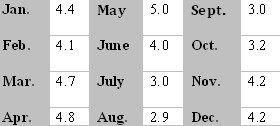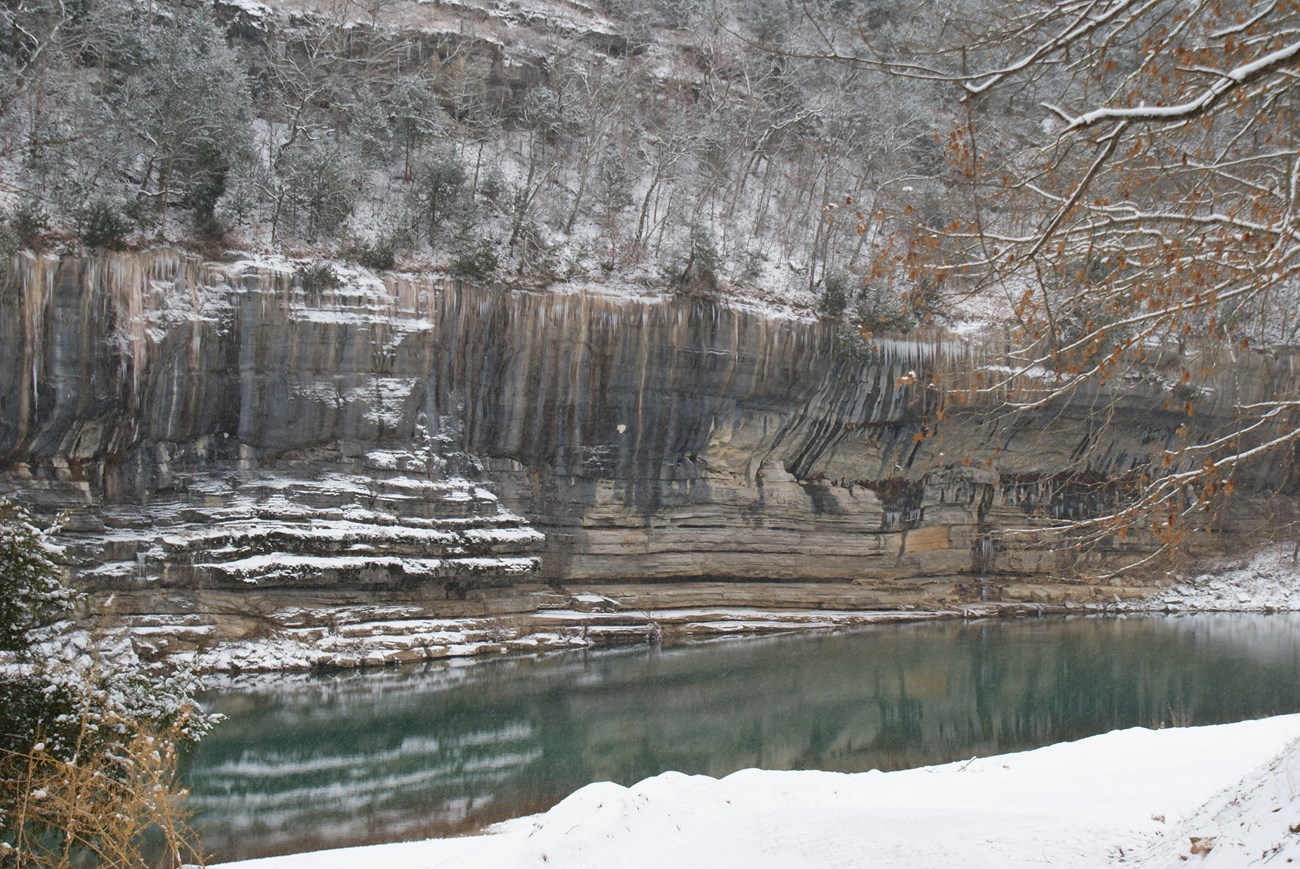
Data from NRCS Located in northern Arkansas, the Buffalo National River is a unique resource that characterizes the Ozark highland region. The natural setting, its topography and the distribution of its resources, both circumscribes and affords scope to the cultures, both historic and prehistoric, that found their way into the Buffalo River watershed. Soil, vegetation, and water determine the distribution of resources such as wildlife, arable land, durable resources (building materials and materials used as tools). Invariably, the land of the Buffalo River watershed is a mosaic of limitations and opportunities. The Buffalo River has cut deeply onto the bedrock, leaving tall, vertical bluffs standing at river bends. In some areas the river is confined by bedrock; in others it meanders through alluvial bottoms. The channel is vertically stable as the bedrock is either exposed or covered with a thin layer of gravel and sand. The river is characterized by quiet pools separated by short riffles. From Ponca to Pruitt the river falls an average of 13 feet per mile. From Pruitt to Highway 65 the average gradient is five feet per mile, and from there to the mouth it is about three feet per mile. The elevations within the Buffalo River watershed range from 2,576 feet above sea level in the Boston mountains to 351 feet above sea level where the Buffalo River empties into the White River. The hills or ridge tops surrounding the river are usually narrow and winding, the sides alternate in steep slopes and vertical escarpments. The watershed is characterized by three physiographic regions, the Springfield Plateau, the Boston Mountains, and the Salem Plateau. The Springfield Plateau occupies about 47% of the Buffalo's watershed and is underlain by limestone and cherty limestone of Mississippian age. Land surface altitudes range from 1,000 to 1,700 ft but locally topographic relief rarely exceeds 200 to 300 ft. Sinkholes and springs are common in this region. The Boston Mountains occupies 34% of the watershed. They are underlain by sandstone, shale, and limestone of late Mississippian to Pennsylvanian age. Land surface altitude ranges from 1,200 to more than 2,300 ft above sea level and topographic relief is as much as 1,000 ft in some places. The topography is rugged with narrow divides separating steep-sided valleys. Finally, the Salem Plateau occupies 19% and is underlain by rocks of the Cambrian and Ordovician age. The upland is characterized by gently rolling hills and local relief is 50 to 100 ft in the upland area. The rocks of Buffalo National River are entirely sedimentary, laid down in an ancient marine basin. Over its 300-million year history it was variously uplifted and eroded and then again submerged below the sea to receive more deposits. Deposition of the strata was discontinuous, and unconformities have been left in the sequence. Most of the rocks contain invertebrate fossils - trilobites, brachiopods, crinoids, cephalopods. Today the rocks are again uplifted and superimposed on them are high bluffs, waterfalls, springs and hundreds of solution pits and caves. Two features are especially noteworthy; one, the 200-foot waterfall in Hemmed-in-Hollow, which is the highest in the entire region between the Appalachians and the Rocky Mountains; the other, the gypsum formations of Beauty Cave. The basin is underlain by gently folded sandstone, shale, cherty dolomite, and limestone of Pennsylvanian to Ordovician age. Unlike most Ozark streams, the Buffalo River's watershed contains a substantial amount of sandstone and shale. The Pennsylvanian sandstone and shales occupy a large part of the upland, particularly in the upper basin. Most of the river itself is underlain by the St. Peter sandstone and Everton Formations. The prevalence of sandstone and shale, as well as the relatively small amount of chert in the upper strata, substantially affects the size and availability of transportable sediment. However, typical of the Ozarks regions, approximately 64% of the basin is underlain by limestone and dolomite formations. The Boone formation, a karstic cherty limestone formation, occupies the largest part of the basin (31.8%) and underlies many tributaries and a substantial part of the mainstem of Buffalo River. The source of Buffalo River is in the Boston Mountains physiographic subregion, a region composed primarily of Pennsylvanian clastic sediments. The Boston Mountains form an east-west belt of rough country where dissection of rocks is greater than in the surrounding Springfield Plateau. The boundary of the Boston Mountains with the Springfield Plateau is marked by a prominent north-facing escarpment capped by resistant sandstone. The Boston Mountains are remnants of the Ozark Plateau that have been eroded to produce the steep-sided valleys separated by high flats and ridges apparent today. The Springfield plateau is composed mainly of Mississippian limestones and cherts, with minor amounts of sandstones, and shale. The Salem plateau, in the park, is composed of sedimentary rocks of the Ordovician, Silurian, and Devonian age. These rocks are comprised primarily of calcium carbonate (limestone) and calcium-magnesium carbonate (dolomite) sedimentary rock and clean sandstones. The large-scale geologic processes affecting the park are; erosion and sedimentation associated with the river and adjacent slopes, and dissolving of carbonate rocks (limestones and dolomites) to form caves and karst topography. Geologic processes associated with the river include movement of sediment and gravel during high-flow events and the associated features such as gravel bars and bluffs which result. Climate, geography, and geologic processes provide the attendant conditions that influence the biological composition and ecology of a region. In return, the living components of an ecosystem effect the soils and topography by influencing erosion and deposition with their presence and activities at the interface of the living and non-living ecosystem components. This connection is especially evident in the karst topography of southern Missouri and Northern Arkansas. Karst landscape features form when rain water containing carbon dioxide from the atmosphere and dead plant matter percolate into cracks and chemically dissolve the calcium carbonate-based rock. Over time, gravity, hydraulic pressure, chemical dissolution, and abrasion by moving sediment enlarge the cracks. The result of the continuous movement of this groundwater is the production of the karst features visible at Buffalo National River including; sinks, springs, losing streams and caves. Inventories within the park have identified approximately 500+ caves, 200+ shelters, 120+ karst features, and 200+ springs. Caves are protected areas within Buffalo National River; many are gated and off-limits to visitation for safety and resource protection purposes.The climate of the Buffalo River basin is characterized by long, hot summers and relatively short, mild winters. Temperature records at Harrison run from -13 F to 107 F. Rainfall varies between 30 to 80 inches and averages 46 inches annually in Harrison, AR. The greatest amounts of precipitation occur in winter and spring, usually around 4 to 5 inches per month. Average winter snowfall is 12 inches. Dryer months in terms of precipitation are July through October, when monthly precipitation is around 3 inches. In spite of the fairly uniform precipitation, runoff varies widely by season and dry river sections are common in late summer and fall, except in the lower reaches where it usually maintains floatable conditions year round. Both moderately intense local storms and storms with heavier rainfall can last several days. Larger storms are more likely to occur in spring; however, they can occur any time during the year. Relative humidity ranges from moderate to quite high; tornadoes often occur during spring and summer months. The growing season is 200 days annually, indicating that vegetative recovery from impacts of construction or overuse would be fairly rapid on good soils. 
NPS Photos |
Last updated: April 12, 2018
